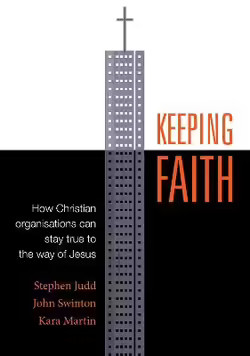If you follow news of the persecuted church, you are used to seeing images of crosses being removed and other acts to demolish churches in places like China. So it is jarring to see the same happening in Canberra.
On Sunday, the last day the Little Company of Mary ran Calvary Public Hospital in North Canberra, the big blue cross was removed from the hospital after a staff barbecue was held on Saturday. The ACT government has forcibly acquired the hospital with special legislation passed in May. Court action by the Catholics failed to halt the takeover.
More than 1,700 Calvary Hospital staff – including the entire executive team – have transitioned to the employment of Canberra Health Services (CHS), the ABC reports. The Hospital is now called the North Canberra Hospital.
Michael Bird, deputy principal at Ridley College Melbourne, sees the change as more than a simple property transfer.
“The very first thing a totalitarian government does, when it seizes Christian assets, the very first thing they all do … they take down the crucifix,” Canberra’s Catholic Archbishop Christopher Prowse remarked at lunch, the afternoon the cross came down.
“When the religious cage is shaken by a wolf when the cross … is taken down, we realise how important our religion is when it’s under attack.
“And right now today, over at the public hospital — today is Sunday, of all days they picked is the Christian gathering-time — they’re taking the very big blue cross from outside the public hospital down today.
“There was a collective wrenching going on, but there was a sense of hope because they realised you can take down our physical crucifixes, but you’ll never take away the cross, Jesus’s cross, inside my heart.”
To which the ACT government responded by pointing out that the Catholics had removed the cross and some other symbols themselves on the last day they ran the hospital. However, there was no suggestion by the government that the cross would have stayed on the building. Catholics preferred to do the removal themselves rather than leave the government to do it.
The ACT Health Minister Rachel Stephen-Smith has said consistently that the hospital acquisition was a question of efficiency and not about the church. This could be seen as an implicit criticism of public health systems in the rest of Australia, with Catholics and other religious organisations running public hospitals such as St Vincents in Sydney and Melbourne and the public hospitals run by the Calvary organisation in Melbourne, Newcastle, Kogarah, and Riverina.
The toppling of the cross from Calvary Hospital in Canberra is a visual symbol posing whether religious groups will be forced out of their significant role in community services in Australia. Only some Western countries are organised with a significant religious component in health care – the United Kingdom has the National Health Service, including all large hospitals; on the other hand, only a third of hospitals in the Us are state-owned.
Australia is also an outlier in the large independent sector of school education.
35,000 Canberrans signed a petition to keep the Calvary Public Hospital. But the Labor/Green government pushed ahead.
Perhaps the best advocacy for Christian involvement in health and other community services is to serve, especially those who do not share our faith. The nuns and the staff at St Vincents Hospital in Sydney are a great example.
In an appeal for St Vincents, CEO Anthony Schembri, himself a gay man, writes, “I first joined St Vincent’s Hospital as a 22-year-old social worker on Ward 17 South, caring for patients and their families through the devastation wreaked by the HIV/AIDS epidemic. In addition to facing death, a number of patients felt alone as some family and friends turned their backs. The courage and commitment of St Vincent’s Hospital doctors, nurses and allied health support workers during this horrendous time never wavered. But, I know from first-hand experience that maintaining that commitment was not easy.
“On a particularly painful day I was in the nurses’ station shedding tears after the death of yet another patient. Sister Margaret Mines, our Pastoral Care Worker, came and put her arms around me. I said, ‘Sister I don’t think I can do this anymore; it is too hard.’ I will never forget that she said to me, ‘It is because it is hard that we should do it.’ I learnt that was the St Vincent’s way.”
That story demonstrates the complexity behind the Calvary story. Will the staff of a hospital be Christian? The CEO? Or is the presence of the nuns enough? There will be tussles over precisely what a Cross on a building means. How “Christian” does an organisation need to be to be called “christian?”. What exactly are we fighting over?
But to return to the toppled cross. It does represent a shoving of religion from public spaces. What’s the best response? Christian organisations surely need to renew their social license.
It may be that the place Christian organisations have in society is simply out of inertia. Christians founded them but have lost that flavour or now serve a hostile clientele – some schools may be in this category. Once, they could comfortably rely on society’s respect for their Christian stance. But now it’s time to demonstrate that running a Christian organisation makes it better.
“Keeping Faith” is a book of recipes for running a Christian organisation published this year. One of the authors, Stephen Judd, has the lived experience of building HammondCare into a widely respected healthcare organisation as an “Independent Christian Charity. How to align an organisation’s day-to-day practices with deep theological reflection is a key concern in “Keeping Faith.” The Other Cheek’s review is here.

The message of the book is that organisations need to be genuinely Christian. HammondCare was literally reborn under Judd. Other organisations are re-engaging with the Christian roots. Mission Australia is an example of this.
How does this work out in real life? Here’s one of the powerful stories from Keeping Faith.
“‘I have a friend who is just out of prison who needs a job.’ With these words, the manager got the CEO’s attention. The manager went on to explain that his friend James had been in prison for two years and needed a job.” The CEO reviewed the legal proceedings involved in James’ previous role as a finance director, issuing misleading documents, and authorised James’ appointment to a junior role. “Later, as James’ contributions became more and more valued, the CEO was asked to authorise James’ promotion to a position that would interact with the board. After further consideration, he approved the new appointment.
“At the next board meeting, the CEO advised directors of James’ appointment. Not all board members were happy: concerns about possible reputational damage were voiced. Another made the comment that ‘past behaviour is the only indicator of future behaviour.’ The CEO’s pause button was not on, and he replied, ‘In which case we are all condemned!'”
Perhaps the best response we can have to the cross at Calvary Hospital being toppled is to make sure that we build deeply Christian organisations that go the “second mile” in service of the needy and the treatment of staff. This is not to dismiss discussion in the public square, like Michael Bird’s.
But the larger task surely is to make sure hospitals or schools run by Christians are truly better for being Christian. And for those engaged in that work, The Other Cheek salutes you.

